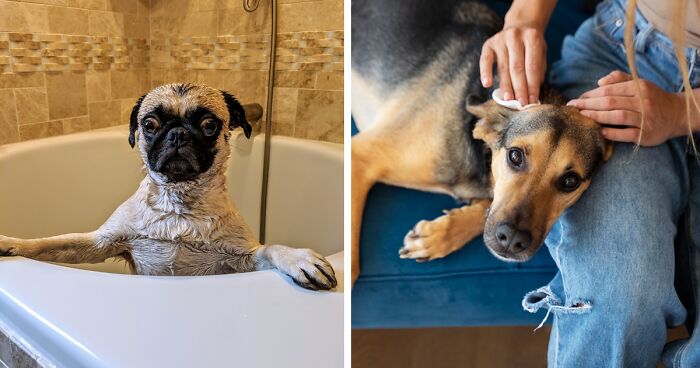Fleas are common, tiny parasites that make life uncomfortable for dogs worldwide. These wingless insects not only irritate but can also transmit diseases. Their complex life cycle, with stages on and off their hosts, makes getting rid of them challenging.
To spot a flea problem, watch for excessive scratching or biting at the skin, and you might even see tiny black specks (flea dirt) in their fur. But don’t worry; there are solutions. Treatments include – topical medications, oral pills, and environmental controls, like cleaning your home thoroughly.
- Fleas cause FAD and anemia, and can transmit diseases.
- Vet-prescribed flea treatments are safer and more effective.
- Prevention includes oral and topical treatments and home cleaning.
In this article, we’ll explore how dogs get fleas and recognize the signs of an infestation. We’ll also look at effective treatments. Let’s dive in!
The information provided herein is for informational purposes only. Please refer to our disclaimer for more details..
How Do Dogs Get Fleas?

Image source: Heiko Giesberg
Dogs commonly get fleas by mingling with other infested animals and in places where these pests thrive. Fleas easily hop from host to host and love environments previously visited by infested animals like dogs and cats. As female fleas can lay up to 40 eggs per day, it would only take a few fleas to result in rapid household infestation.
Therefore, it’s crucial—especially for dog owners—to keep up with regular flea prevention.
Contact with Infested Animals
- Interaction with Other Dogs: Dogs often pick up fleas from their peers during walks, playdates, or in dog parks. Fleas, being great jumpers, easily leap from one dog to another, a situation quite common in these friendly gatherings.
- Engagement Behaviors: When dogs engage in sniffing and playing, or simply come into close physical contact, they open doors for fleas to hop aboard. These fun activities can inadvertently spread these tiny pests.
- Exposure to Various Animals: It’s not just dogs; contact with other animals like cats, rabbits, or even wildlife can introduce fleas to your dog. Such interactions can be unexpected but are potential sources of flea infestations.
- Risks in Communal Settings: Places where dogs congregate, such as dog parks, kennels, or grooming facilities, present a higher risk of flea transmission. In these settings, one flea-infested animal can potentially infest several others.
Environmental Transmission
Fleas don’t just spread from animal to animal—they also thrive and transmit through various environmental factors. Understanding these factors is a big step in preventing and controlling flea infestations in dogs.
- Hitchhiking Fleas: Surprisingly, dogs can get fleas through human interaction with the environment. Fleas can cling to clothing and shoes, and they can even leap through screened windows or doors. This means that indoor pets are also at risk if these parasites are accidentally brought inside the home.
- Backyard Exposure: Dogs are often exposed to fleas right in their backyards. Fleas can live in the grass, lying in wait for a host. Wild animals, like raccoons or squirrels, passing through can leave fleas or flea eggs behind, which may then jump onto your dog.
- Wildlife as Carriers: Besides domestic animals, wild animals are significant flea carriers. A dog’s interaction with wildlife or exploration in areas frequented by wild animals can heighten the risk of flea infestation.
- New Environments: When dogs stay in new places, like campgrounds, kennels, or even a friend’s house, they can be exposed to fleas. These environments might have fleas from previous animal visitors.
Other Household Pets
Flea risks in dogs don’t only come from outside. Other pets in your home can also carry these pesky fleas, spreading them around your living space.
- Cats as Carriers: Cats, no matter if they roam outside or stay indoors, are often flea carriers. They can carry fleas into your home, infecting dogs. Even cats that mostly stay inside can get fleas—these cat fleas can then jump onto other pets.
- Small Mammals: Fleas don’t just affect cats and dogs. Small furry friends like rabbits, guinea pigs, and ferrets might also have fleas. If they go outside or mingle with other animals, they’re at higher risk.
- Shared Living Spaces: Fleas easily hop between animals that share spaces like beds, furniture, and carpets. These areas can hide fleas and their eggs, making it easy for fleas to move from one pet to another.
- Importance of Treating All Pets: To stop flea infestations, it’s key to treat every pet at home. This means dogs, cats, and any other furry pals. Each pet needs the right flea control product, as some dog products can harm other animals, especially cats.
By understanding that all household pets can add to flea issues, pet owners can take broad steps to shield all their pets from these pests.
How Can You Tell if Your Dog Has Fleas?

Image source: freepick
Spotting flea infestations in dogs means watching for certain physical and behavioral signs. These clues are crucial—they let pet owners catch an infestation early, which makes treatment more effective and quicker.
Physical Indicators
- Presence of Fleas: Adult fleas are tiny, quick insects, dark brown or black, and visible without needing a magnifying glass. They are often spotted scampering in the dog’s fur.
- Flea Dirt: This looks like small, dark specks in the dog’s coat—actually, it’s flea waste. It’s mostly seen on the lower back, tail base, back of the legs, and groin area. A handy trick is to put these specks on a wet paper towel—if they turn reddish-brown, they are likely flea dirt.
- Hair Loss and Skin Redness: Constant flea bites can cause hair to fall out, as seen in areas where the dog scratches or bites a lot. You’ll also see skin redness and irritation in these spots.
- Flea Dirt Resembling Coffee Grounds: Sometimes, flea dirt piles up so much that it looks like coffee grounds, particularly in spots the dog can’t easily scratch.
Behavioral Signs
- Increased Scratching, Biting, or Over-Grooming: A clear early sign of fleas is a change in how much your dog grooms itself. Dogs with fleas may scratch, bite, or lick themselves more often—especially near the tail, ears, and belly.
- Restlessness: A dog bugged by fleas often seems uncomfortable and can’t settle down, mainly due to the non-stop itching.
- Unusual Biting: Dogs might bite their skin or try to nibble at hard-to-reach areas like their back or tail base, where fleas love to hang out.
Spotting these symptoms early is key to effectively deal with flea infestations. If you see any of these signs, it’s vital to talk to a vet for the right diagnosis and treatment options. Acting quickly can stop worse problems like skin infections or allergic reactions caused by fleas.
Why You Should Be Concerned About Dog Fleas
Flea infestations in dogs are more than just uncomfortable—they can lead to several serious health problems. It’s important to understand these issues to keep your dog healthy.
Flea Allergy Dermatitis (FAD)
- Allergic Reaction to Flea Saliva: FAD is an intense allergic reaction to proteins in flea saliva. When a flea bites, it can cause a severe allergic response in sensitive dogs.
- Symptoms: This allergy causes extreme itching and skin irritation. Dogs often have red, inflamed skin, and might develop secondary skin infections due to non-stop scratching and biting.
Anemia
- Blood Loss from Flea Bites: Fleas feed on blood. In heavy infestations, especially in small or young dogs, they can take enough blood to cause anemia.
- Signs of Anemia: Look out for tiredness, pale gums, and low energy. Anemia from fleas needs quick veterinary care.
Transmission of Diseases
- Tapeworms: Dogs can get tapeworms if they swallow flea-carrying tapeworm larvae during grooming.
- Yersinia pestis: In rare situations, fleas can spread Yersinia pestis, the bacteria behind the bubonic plague, mainly in areas with lots of rodent fleas.
- Other Diseases: Fleas might also carry other harmful bacteria and viruses.
Understanding these health risks shows why it’s so crucial to control fleas quickly. Regular vet visits can help catch and treat these issues early on.
Best Flea Treatments for Dogs: How Do I Get Rid of Fleas on Dogs?
Dealing with fleas in dogs involves treating your pet and taking care of the environment to stop the flea cycle.
Flea Medications
Flea medications are key for treating and preventing fleas in dogs. You can find these as oral pills, skin treatments, or collars.
Oral Medications
Oral treatments, like Simparica®, NexGard®, Bravecto®, and Credelio®, are often vet-recommended. Given monthly, they kill adult fleas as well that bite your dog.
Emergency Use: Over-the-counter pills such as Capstar® and Advantus® work fast but aren’t long-term fixes.
Topical Treatments
Products like Frontline Plus® and K9 Advantix II® go on your dog’s skin, usually monthly. They start killing fleas in 12-48 hours.
Flea Collars
Flea collars, such as the Seresto collar, release flea-killing ingredients over time. They work well, but their effectiveness can vary depending on your dog and home.
Physical Removal
Flea Comb: A fine-toothed metal comb can help physically remove fleas and their eggs. Use a flea comb in a specified area, so fleas can’t infest the environment further,
Flea Shampoos: They offer quick relief but don’t provide lasting protection.
How to Control Fleas in the Environment
Home Cleaning: Regularly vacuuming your home is essential to get rid of flea eggs and larvae from carpets and furniture. Washing your pet’s bedding in hot water helps kill off fleas.
Room Sprays and Powders: Choose products that are safe around pets yet effective against fleas.
Professional Help: In extreme cases, you might need professional exterminators to fully get rid of fleas.
Remember, while these steps help control fleas, the best thing to do is talk to your vet. They can look at your pet’s unique situation and suggest the best treatments. Plus, your vet can guide you on safely using flea control products, keeping your pet and family safe.
How to Prevent Fleas on Your Dog in the Future
Preventing flea infestations in dogs is crucial for their health and happiness. Here’s a simpler guide:
- Flea Preventatives: These are varied—like pills, skin creams, collars, sprays, and shampoos. Each has a unique role and effectiveness.
- Oral Preventatives: These are easy-to-give pills, tablets, or chews. Give them regularly to fight fleas and their life cycle.
- Topical Treatments: Apply these creams or liquids on your dog’s skin every month. They do more than fight fleas—they often guard against other pests. Flea sprays and shampoos are quick fixes but don’t last long.
- Environmental Management: Keeping your home and yard clean is key. Regular vacuuming and washing of fabrics in your home, plus yard upkeep, help lower flea hideouts.
- Regular Vet Visits: These are vital. Your vet can pick the best flea prevention, especially if your dog takes other meds or has health issues.
Remember, products prescribed by a vet are usually more effective and safer than what you find in stores. Plus, these steps protect both your dog and people from flea-related problems.
Conclusion: How to Check and Treat Your Dog for Fleas
To effectively fight flea infestations in dogs, it’s crucial to grasp how fleas spread—understanding this helps in early symptom detection. Using the right treatment and prevention methods is essential, as these pests can lead to severe health problems, like allergies and diseases. But, prevention stands as the best strategy. Always seek a veterinarian’s advice for personalized plans—they can guide you on the best path forward,
FAQs about Fleas on a Dog
Can a dog randomly get fleas?
Dogs can randomly get fleas from various sources. They can catch fleas from other animals, through contact with flea-infested environments, or even bring them in from outdoors on human clothing or shoes. Fleas are excellent jumpers and can enter homes through windows or attach to pets directly.
Where do dog fleas come from?
Dog fleas originate from environments where fleas are present or from other flea-infested animals. Flea and ticks can be found almost anywhere, especially in warm environments, and can survive indoors in colder months. They easily transfer from host to host and their eggs can be left in different environments, waiting for a new host.

 Dark Mode
Dark Mode 

 No fees, cancel anytime
No fees, cancel anytime 


















































-3
0